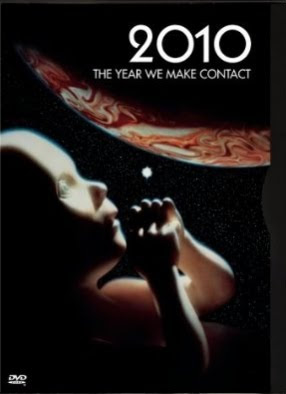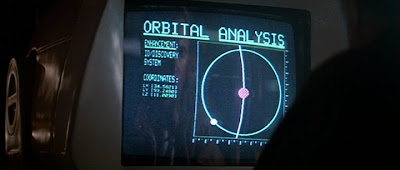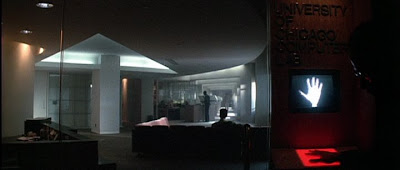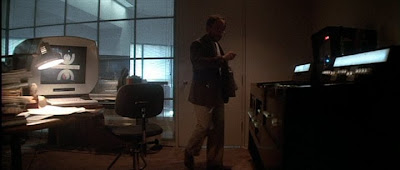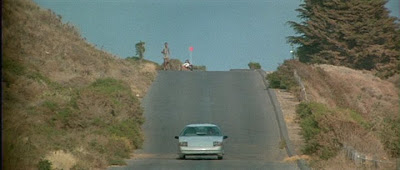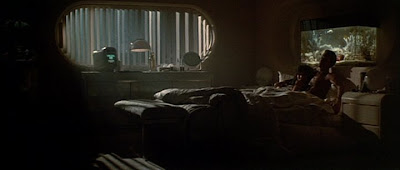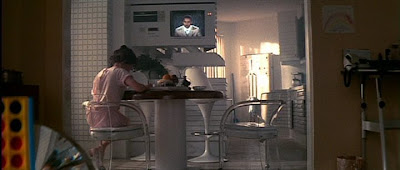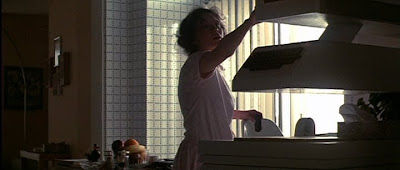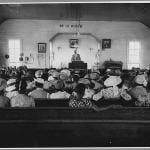It’s a sign of how busy my life has become, and how slow my blogging has become, that I am only getting around to this now, but anyhoo.
On New Year’s Day, I greeted the new decade, as many people are calling it, by pulling my copy of 2010: The Year We Make Contact (1984; my comments) off the shelf, watching it, and taking a few screen captures. As always, I basked in the still-glorious special effects and cringed at the non-stop exposition, but what I really focused on this time, of course, was how the film imagined our world would look today.
Well, okay, not quite today, exactly. Because the flight to Jupiter lasts about two years, most of what this movie depicts is the world of 2008: the entire first act takes place before the main characters go into space, and of course the ship they use to get there had to be built before it was launched. But the film does give us a few brief glimpses of life back on Earth after the ship arrives at Jupiter, too, so it’s all good.
The first thing that stands out to me are the enormous computer screens, which may have looked kind of normal when the movie was made 25 years ago, but now just seem kind of monstrous:
Things get a little more complicated when Bob Balaban goes to his computer lab. He, too, has an enormous screen or two in his office, but he also has a computer named SAL, which is sort of the sister to HAL, the computer that went psycho in Stanley Kubrick’s 2001: A Space Odyssey (1968). And because this film is a sequel to Kubrick’s film, it has to give SAL the same relatively simpler design that HAL had.
The film includes a few scenes of Roy Scheider explaining his upcoming mission to his wife and son. In one, he goes jogging while his son tags along, and they are passed by a car, and while the car doesn’t look particularly futuristic, it does make a sound that suggests it runs purely on electricity, and not on gas:
We also get the following glimpses of the inside of Scheider’s home, and because his wife is a marine biologist, the bedroom has an aquarium and the dining room has a pool that the dolphins can access from outside:
Later on, there is a scene in which the ghost of Keir Dullea visits his former wife by appearing on her TV, and we see her apartment from a couple angles, too — and for some reason, there is a keyboard attached to the bottom of the TV but it is not facing in the same direction that the actual TV screen is:
Finally, I didn’t bother to capture any images aboard the spaceships, because there aren’t really any real-world equivalents for them yet — and in any case, the movie was obliged to make at least one of those ships look consistent with the spaceships that Kubrick had designed way back in the 1960s, so it isn’t really fair to hold those up as an example of how people thought the future would look when this particular movie was made. But I couldn’t resist capturing one more image that shows how blocky computer graphics used to be, and how the filmmakers of the 1980s apparently expected them to remain:
Finally, perhaps the best bit of technological backwardness comes not in any of the visuals, but in a line of dialogue. After Balaban and John Lithgow have been woken from suspended animation, they ask Scheider for certain bits of information, and Scheider replies, “They’re all in your cassettes.” Cassettes? Seriously? People had been using floppy discs since the 1970s — I myself had been using them at home for over two years when this movie came out — so why on earth would anyone looking a quarter-century into the future have thought that cutting-edge federally-funded spacemen would still be using tapes, of all things?
One last trivia note: Dullea’s widow, the woman reaching for the TV in one of the images above, is none other than Mary Jo Deschanel, wife of famed cinematographer Caleb Deschanel (The Passion of the Christ, National Treasure) and mother of famed actress Zooey Deschanel, who I adore. And the year before this movie came out, she played Annie Glenn, wife of John, in The Right Stuff (1983). Apparently she had a thing for astronauts.


